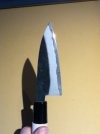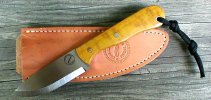For some reason I seem to get scandi grinds sharper than other grinds.
That wide bevel may be acting as a guide to help keep you at a consistent angle. And I believe it is a touch shallower than many knives which are up around 20° . . . the scandi maybe be less. Honestly I never use anything with Scandi much except a wood carving knife a little.
Actually the way some cultures use that wide bevel is AS A SHARPENING GUIDE with the bevel right on the stone until they apex the edge. I don't like that because all that steel loads up the stone unnecessarily. Meaning I would rather have the knife ground way thin and shallow angles then use a faint steeper sharpening bevel. This is way faster to sharpen and wears / loads the stones way less.
've read about different knife steels, but I still don't know why certain steels can get sharper (or can they?), and which types of steels and their ingredients have to do with this. I don't know why I never picked this up along the way. Can someone explain this to me, please?
Nah that's mostly nonsense at least the sharpness right off the stone for that first hair whittling test.
From there on out things get ugly.
For instance I can get S110V silly hair whittlingly sharp and I can get 1095 or White Paper steel just as sharp.
Now the latter is more fun to sharpen and may even seem a bit sharper but hair whittling is pretty sharp right ?
From there the S110V looses that level of sharpness in not too long a time.
Depending on the material cut the 1095 or White Paper steel may maintain that level of sharpness for a while or loose it as quick as the S110V depending on what is cut.
The S110V is going to keep cutting for a long time in material that is abrasive and otherwise more challenging far longer than the other two steels mentioned if the heat treat and the geometry is optimized for the steel and the material being cut even though the hair cutting test is long failing the test.
NOW
This knife from White Paper steel, after a year of kitchen use, very careful use only slicing fruit and opening food packages, is still hair wittingly sharp in places where the edge has been used a lot (haha not just up next to the handle).

To use S110V for this application would just be bizarre and a waste of steel, time and sharpening equipment. Did I mention I hate using diamonds and only subject myself to it for the high vanadium steels ?
On the other hand I LOVE using waterstones and enjoy sharpening the steel that works best with those stones.
How to get the 1095 or White Paper steel that sharp ?
Edge Pro Apex with water stones.
How to get the S110V steel that sharp ?
Edge Pro Apex with diamond stones up to and including diamond 8,000
Starting to see a pattern here ?
Good.





